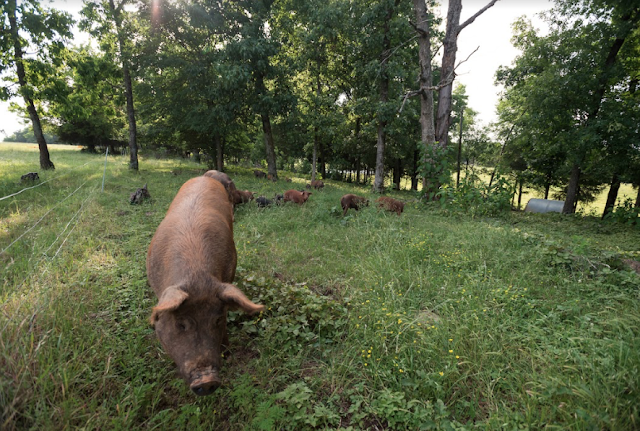People sometimes ask me, "Where should I start on my real food journey?" Buying healthier meat can be an easy transition to a healthier lifestyle. Most of your family members won't even know (unless they're used to eating lots of processed meat like hotdogs and bologna). However, locally grown meat comes at a price just a bit more than $1 steak. Yesterday Tara explained that you can't really compare the nutrition of grocery store food and that from small farms who are intentional. Katie has shared before some tips for eating less meat which helps us stay within the budget.
So what's the healthiest meat?
The absolute healthiest meat would be that you have raised yourself on plenty of pasture and know everything about the animal. Granted 99.9% of us aren't farmers so we look for other sources.
Next healthiest option is to buy directly from a farmer. Get to know your farmers and ask them questions about their treatment of animals. Not all farmers are as intentional as our dreams so be sure to ask questions like: What do the animals eat? (The answer should be mostly grass.) How much time do they spend on grass? How large is the farm? How much grain are they given? GMOs? What about the water source? Are animals rotated to new pastures? How many animals does the farmer process annually?
 |
| photos used by permission from Bryan Clifton & Grass Roots Co-Op |
Animals raised primarily on grass are healthier to eat because when given too many grains, it changes the omega 3 and omega 6 ratios in the fat. Translated to humans, too much omega 6 causes inflammation -- which is the root of all disease.
Grass finished animals have more conjugated linoleic acid (CLA) which is a polyunsaturated fatty acid that some believe fights cancer. You'll also find high amounts of CLA in grass based milk products as evidenced by very yellow butter.
 |
| photos used by permission from Bryan Clifton & Grass Roots Co-Op |
 |
| photos used by permission from Bryan Clifton & Grass Roots Co-Op |
 |
| photos used by permission from Bryan Clifton & Grass Roots Co-Op |
Local meat farmers that I've trusted to feed my family include:
- FarmGirl (whose meat share opens September 15),
- Way to Grow (budding new family farm, processing chickens this weekend and next)
- as well as other small farmers that have recently joined a co-op.
My third choice when choosing meat would be from a co-op like Grass Roots Farmers CoOperative. Monday, I will write more about Grass Roots but I want to encourage you to check out their site now. They have a special deal until the end of September and they deliver straight to your door, no shipping costs.
Forth choice would be to find a hunter or angler to share their wild bounty with you! Maybe I should move this choice closer to the top of the list. My parents, whose garden is regularly destroyed by deer, would probably put venison at the top of this list.
Fifth choice would be grocery store meat. Some grocery stores will carry meat that has been marked "no-antibiotics." Natural Grocers and Whole Foods are safer places to buy meat. You cannot buy meat from either store that has been fed antibiotics. Kroger's Simple Truth brand doesn't always have antibiotics (but please always look closely at the packaging...not all Simple Truth is antibiotic-free.) The down-side of grocery store meat is that you know nothing about the farmer's standards or the animals living conditions.
As far as I know, it is a federal law that animals raised for meat cannot be given growth hormones. Some dairy cows are given growth hormones to promote lactation. Unless your dairy is organic or labeled rBST-free, there is a good chance that it is tainted with growth hormones.
When it comes to food, we have many choices. Educate yourself. We vote 3 times a day with our fork.
Yours for nutritionally dense food on the table,
Julie
Related: Why pay more for grass based meat?


No comments:
Post a Comment